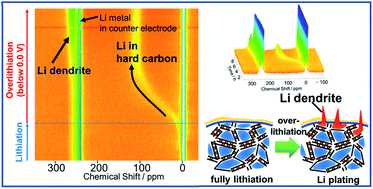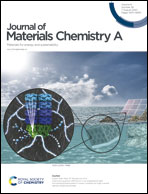Mechanisms for overcharging of carbon electrodes in lithium-ion/sodium-ion batteries analysed by operando solid-state NMR†
Abstract
A precise understanding of the mechanism for metal (Li and Na) plating on negative electrodes that occurs with overcharging is critical to managing the safety of lithium- and sodium-ion batteries. In this work, an in-depth investigation of the overlithiation/oversodiation and subsequent delithiation/desodiation of graphite and hard carbon electrodes in the first cycle was conducted using operando7Li/23Na solid-state NMR. In the 7Li NMR spectra of half cells of carbon electrodes and metal counter electrodes, three types of signals corresponding to Li dendrites that formed on the surface of graphite, hard carbon, and the counter electrode were distinguished from the signal of Li metal foil of the counter electrode by applying an appropriate orientation of the testing cell. For graphite overlithiation, the deposition of Li dendrites started immediately or soon after the minimum electric potential in the lithiation curve. In contrast, the deposition of Li dendrites in hard carbon started after the end of quasimetallic lithium formation for overlithiation at rates below 3.0C. Similar behaviour was also observed for the oversodiation of hard carbon. The formation of quasimetallic Li or Na in the pores of hard carbon serves as a buffer for the metal plating that occurs with overcharging of the batteries. Furthermore, some of the deposited Li/Na dendrites contribute to reversible capacities. A mechanism for the inhomogeneous disappearance of quasimetallic Li during delithiation of hard carbon is also proposed.



 Please wait while we load your content...
Please wait while we load your content...